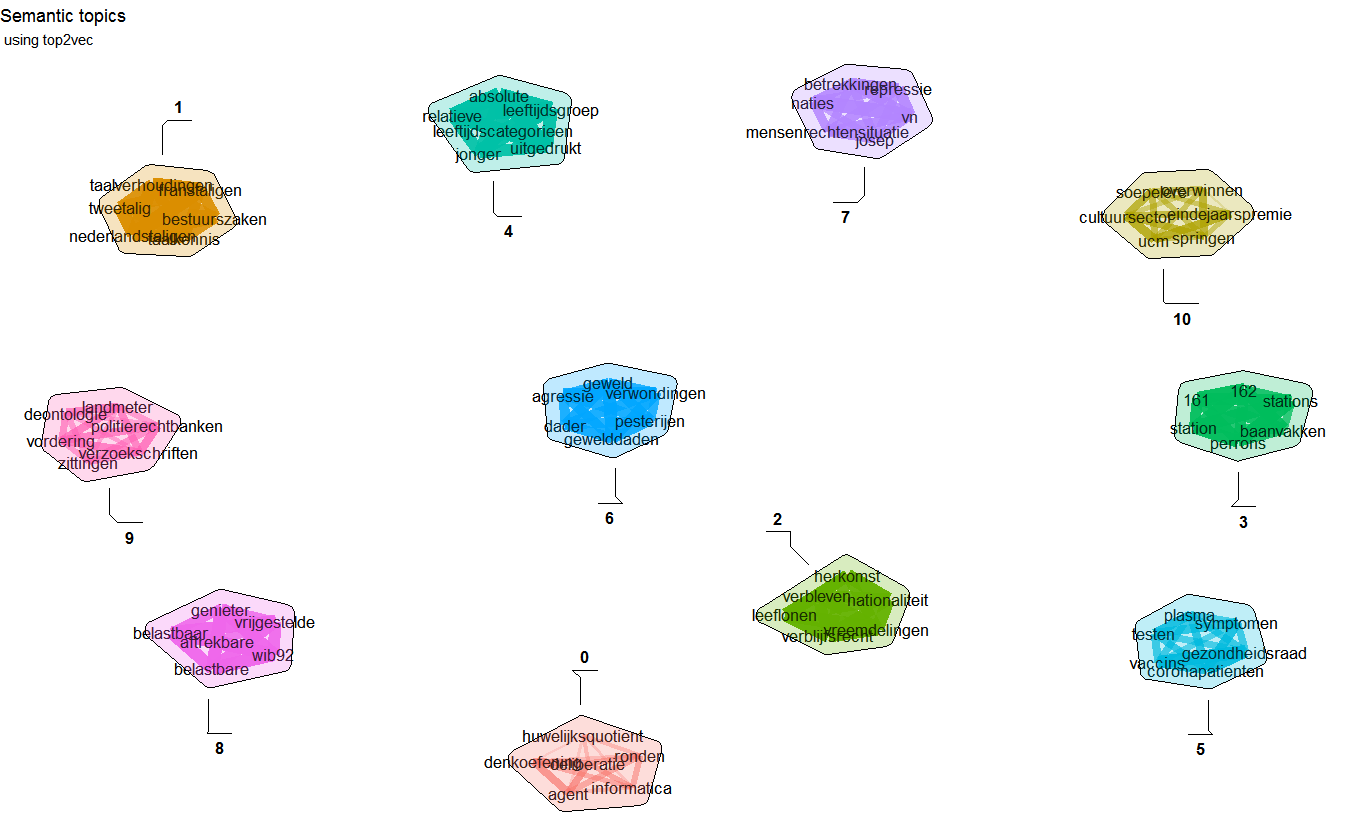
This repository contains an R package allowing to build Paragraph Vector models also known as doc2vec models. You can train the distributed memory (‘PV-DM’) and the distributed bag of words (‘PV-DBOW’) models. Next to that, it also allows to build a top2vec model allowing to cluster documents based on these embeddings.
install.packages("doc2vec")remotes::install_github("bnosac/doc2vec")Look to the documentation of the functions
library(doc2vec)
library(tokenizers.bpe)
library(udpipe)
data(belgium_parliament, package = "tokenizers.bpe")
x <- subset(belgium_parliament, language %in% "dutch")
x <- data.frame(doc_id = sprintf("doc_%s", 1:nrow(x)),
text = x$text,
stringsAsFactors = FALSE)
x$text <- tolower(x$text)
x$text <- gsub("[^[:alpha:]]", " ", x$text)
x$text <- gsub("[[:space:]]+", " ", x$text)
x$text <- trimws(x$text)
x$nwords <- txt_count(x$text, pattern = " ")
x <- subset(x, nwords < 1000 & nchar(text) > 0)## Low-dimensional model using DM, low number of iterations, for speed and display purposes
model <- paragraph2vec(x = x, type = "PV-DM", dim = 5, iter = 3,
min_count = 5, lr = 0.05, threads = 1)
str(model)## List of 3
## $ model :<externalptr>
## $ data :List of 4
## ..$ file : chr "C:\\Users\\Jan\\AppData\\Local\\Temp\\Rtmpk9Npjg\\textspace_1c446bffa0e.txt"
## ..$ n : num 170469
## ..$ n_vocabulary: num 3867
## ..$ n_docs : num 1000
## $ control:List of 9
## ..$ min_count: int 5
## ..$ dim : int 5
## ..$ window : int 5
## ..$ iter : int 3
## ..$ lr : num 0.05
## ..$ skipgram : logi FALSE
## ..$ hs : int 0
## ..$ negative : int 5
## ..$ sample : num 0.001
## - attr(*, "class")= chr "paragraph2vec_trained"## More realistic model
model <- paragraph2vec(x = x, type = "PV-DBOW", dim = 100, iter = 20,
min_count = 5, lr = 0.05, threads = 4)embedding <- as.matrix(model, which = "words")
embedding <- as.matrix(model, which = "docs")
vocab <- summary(model, which = "docs")
vocab <- summary(model, which = "words")sentences <- list(
sent1 = c("geld", "diabetes"),
sent2 = c("frankrijk", "koning", "proximus"))
embedding <- predict(model, newdata = sentences, type = "embedding")
embedding <- predict(model, newdata = c("geld", "koning"), type = "embedding", which = "words")
embedding <- predict(model, newdata = c("doc_1", "doc_10", "doc_3"), type = "embedding", which = "docs")
ncol(embedding)## [1] 100## [,1] [,2] [,3] [,4]
## doc_1 0.05721277 -0.10298843 0.1089350 -0.03075439
## doc_10 0.09553983 0.05211980 -0.0513489 -0.11847925
## doc_3 0.08008177 -0.03324692 0.1563442 0.06585038nn <- predict(model, newdata = c("proximus", "koning"), type = "nearest", which = "word2word", top_n = 5)
nn## [[1]]
## term1 term2 similarity rank
## 1 proximus telefoontoestellen 0.5357178 1
## 2 proximus belfius 0.5169221 2
## 3 proximus ceo 0.4839031 3
## 4 proximus klanten 0.4819543 4
## 5 proximus taal 0.4590944 5
##
## [[2]]
## term1 term2 similarity rank
## 1 koning ministerie 0.5615162 1
## 2 koning verplaatsingen 0.5484987 2
## 3 koning familie 0.4911003 3
## 4 koning grondwet 0.4871097 4
## 5 koning gedragen 0.4694150 5nn <- predict(model, newdata = c("proximus", "koning"), type = "nearest", which = "word2doc", top_n = 5)
nn## [[1]]
## term1 term2 similarity rank
## 1 proximus doc_105 0.6684639 1
## 2 proximus doc_863 0.5917463 2
## 3 proximus doc_186 0.5233522 3
## 4 proximus doc_620 0.4919243 4
## 5 proximus doc_862 0.4619178 5
##
## [[2]]
## term1 term2 similarity rank
## 1 koning doc_44 0.6686417 1
## 2 koning doc_45 0.5616031 2
## 3 koning doc_583 0.5379452 3
## 4 koning doc_943 0.4855201 4
## 5 koning doc_797 0.4573555 5nn <- predict(model, newdata = c("doc_198", "doc_285"), type = "nearest", which = "doc2doc", top_n = 5)
nn## [[1]]
## term1 term2 similarity rank
## 1 doc_198 doc_343 0.5522854 1
## 2 doc_198 doc_899 0.4902798 2
## 3 doc_198 doc_983 0.4847047 3
## 4 doc_198 doc_642 0.4829021 4
## 5 doc_198 doc_336 0.4674844 5
##
## [[2]]
## term1 term2 similarity rank
## 1 doc_285 doc_319 0.5318567 1
## 2 doc_285 doc_286 0.5100293 2
## 3 doc_285 doc_113 0.5056069 3
## 4 doc_285 doc_526 0.4840761 4
## 5 doc_285 doc_488 0.4805686 5sentences <- list(
sent1 = c("geld", "frankrijk"),
sent2 = c("proximus", "onderhandelen"))
nn <- predict(model, newdata = sentences, type = "nearest", which = "sent2doc", top_n = 5)
nn## $sent1
## term1 term2 similarity rank
## 1 sent1 doc_742 0.4830917 1
## 2 sent1 doc_151 0.4340138 2
## 3 sent1 doc_825 0.4263285 3
## 4 sent1 doc_740 0.4059283 4
## 5 sent1 doc_776 0.4024554 5
##
## $sent2
## term1 term2 similarity rank
## 1 sent2 doc_105 0.5497447 1
## 2 sent2 doc_863 0.5061581 2
## 3 sent2 doc_862 0.4973840 3
## 4 sent2 doc_620 0.4793786 4
## 5 sent2 doc_186 0.4755909 5sentences <- strsplit(setNames(x$text, x$doc_id), split = " ")
nn <- predict(model, newdata = sentences, type = "nearest", which = "sent2doc", top_n = 5)Top2vec clusters document semantically and finds most semantically relevant terms for each topic

library(doc2vec)
library(word2vec)
library(uwot)
library(dbscan)
data(be_parliament_2020, package = "doc2vec")
x <- data.frame(doc_id = be_parliament_2020$doc_id,
text = be_parliament_2020$text_nl,
stringsAsFactors = FALSE)
x$text <- txt_clean_word2vec(x$text)
x <- subset(x, txt_count_words(text) < 1000)
d2v <- paragraph2vec(x, type = "PV-DBOW", dim = 50,
lr = 0.05, iter = 10,
window = 15, hs = TRUE, negative = 0,
sample = 0.00001, min_count = 5,
threads = 1)
model <- top2vec(d2v,
control.dbscan = list(minPts = 50),
control.umap = list(n_neighbors = 15L, n_components = 3), umap = tumap,
trace = TRUE)
info <- summary(model, top_n = 7)
info$topwordsNeed support in text mining? Contact BNOSAC: http://www.bnosac.be